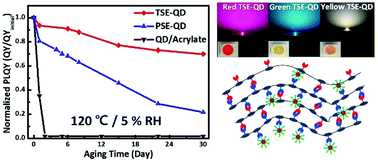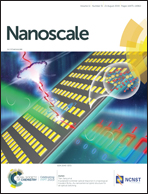Exceptionally stable quantum dot/siloxane hybrid encapsulation material for white light-emitting diodes with a wide color gamut†
Abstract
Herein, we report a luminescent light-emitting diode (LED) encapsulating material using a thermally curable quantum dot (QD)/siloxane hybrid (TSE-QD) color converter, which has superior long-term stability even at elevated temperatures, in high humidity, and in various chemicals. The TSE-QD is cured by a thermal-induced hydrosilylation reaction of an in situ sol–gel synthesized QD dispersed siloxane resin (QD/siloxane resin) without additional ligand-exchange processes. QDs are successfully encapsulated by highly condensed and linear structured siloxane networks with additional chemical linkages between the surface ligands of the QDs and organic functional groups of the siloxane matrix. Moreover, QDs are uniformly distributed within the siloxane matrix retaining their optical properties during the fabrication processes of the TSE-QD. The result is that the stability, as evaluated by the photoluminescence (PL) quantum yield (QY), is greatly improved under harsh conditions, for example, 120 °C/5% relative humidity (RH), ethanol and acetone for 30 days. Based on the exceptionally stable TSE-QD, we demonstrate a white LED using a blue LED chip directly encapsulated by a yellow emitting TSE-QD that shows excellent spectral stability, outstanding reliability at 85 °C/85% RH and a wide color gamut (116% of NTSC).



 Please wait while we load your content...
Please wait while we load your content...